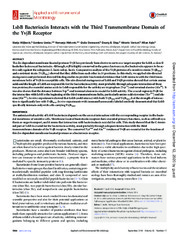Приказ основних података о документу
LsbB Bacteriocin Interacts with the Third Transmembrane Domain of the YvjB Receptor
| dc.creator | Miljković, Marija | |
| dc.creator | Uzelac, Gordana | |
| dc.creator | Mirković, Nemanja | |
| dc.creator | Devescovi, Giulia | |
| dc.creator | Diep, Dzung B. | |
| dc.creator | Venturi, Vittorio | |
| dc.creator | Kojić, Milan | |
| dc.date.accessioned | 2020-12-17T21:34:31Z | |
| dc.date.available | 2020-12-17T21:34:31Z | |
| dc.date.issued | 2016 | |
| dc.identifier.issn | 0099-2240 | |
| dc.identifier.uri | http://aspace.agrif.bg.ac.rs/handle/123456789/4029 | |
| dc.description.abstract | The Zn-dependent membrane-located protease YvjB has previously been shown to serve as a target receptor for LsbB, a class II leaderless lactococcal bacteriocin. Although yvjB is highly conserved in the genus Lactococcus, the bacteriocin appears to be active only against the subspecies L. lactis subsp. lactis. Comparative analysis of the YvjB proteins of a sensitive strain (YvjB(MN)) and a resistant strain (YvjB(MG)) showed that they differ from each other in 31 positions. In this study, we applied site-directed mutagenesis and performed directed binding studies to provide biochemical evidence that LsbB interacts with the third transmembrane helix of YvjB in susceptible cells. The site-directed mutagenesis of LsbB and YvjB proteins showed that certain amino acids and the length of LsbB are responsible for the bacteriocin activity, most probably through adequate interaction of these two proteins; the essential amino acids in LsbB responsible for the activity are tryptophan (Trp(25)) and terminal alanine (Ala(30)). It was also shown that the distance between Trp(25) and terminal alanine is crucial for LsbB activity. The crucial region in YvjB for the interaction with LsbB is the beginning of the third transmembrane helix, particularly amino acids tyrosine (Tyr(356)) and alanine (Ala(353)). In vitro experiments showed that LsbB could interact with both YvjB(MN) and YvjB(MG), but the strength of interaction is significantly less with YvjB(MG). In vivo experiments with immunofluorescently labeled antibody demonstrated that LsbB specifically interacts only with cells carrying YvjB(MN). IMPORTANCE The antimicrobial activity of LsbB bacteriocin depends on the correct interaction with the corresponding receptor in the bacterial membrane of sensitive cells. Membrane-located bacteriocin receptors have essential primary functions, such as cell wall synthesis or sugar transport, and it seems that interaction with bacteriocins is suicidal for cells. This study showed that the C-terminal part of LsbB is crucial for the bacteriocin activity, most probably through adequate interaction with the third transmembrane domain of the YvjB receptor. The conserved Tyr(356) and Ala(353) residues of YvjB are essential for the function of this Zn-dependent membrane-located protease as a bacteriocin receptor. | en |
| dc.publisher | Amer Soc Microbiology, Washington | |
| dc.relation | info:eu-repo/grantAgreement/MESTD/Basic Research (BR or ON)/173019/RS// | |
| dc.rights | openAccess | |
| dc.source | Applied and Environmental Microbiology | |
| dc.title | LsbB Bacteriocin Interacts with the Third Transmembrane Domain of the YvjB Receptor | en |
| dc.type | article | |
| dc.rights.license | ARR | |
| dc.citation.epage | 5374 | |
| dc.citation.issue | 17 | |
| dc.citation.other | 82(17): 5364-5374 | |
| dc.citation.rank | M21 | |
| dc.citation.spage | 5364 | |
| dc.citation.volume | 82 | |
| dc.identifier.doi | 10.1128/AEM.01293-16 | |
| dc.identifier.fulltext | http://aspace.agrif.bg.ac.rs/bitstream/id/2576/4026.pdf | |
| dc.identifier.scopus | 2-s2.0-84987850945 | |
| dc.identifier.pmid | 27342562 | |
| dc.identifier.wos | 000381500700030 | |
| dc.type.version | publishedVersion |


